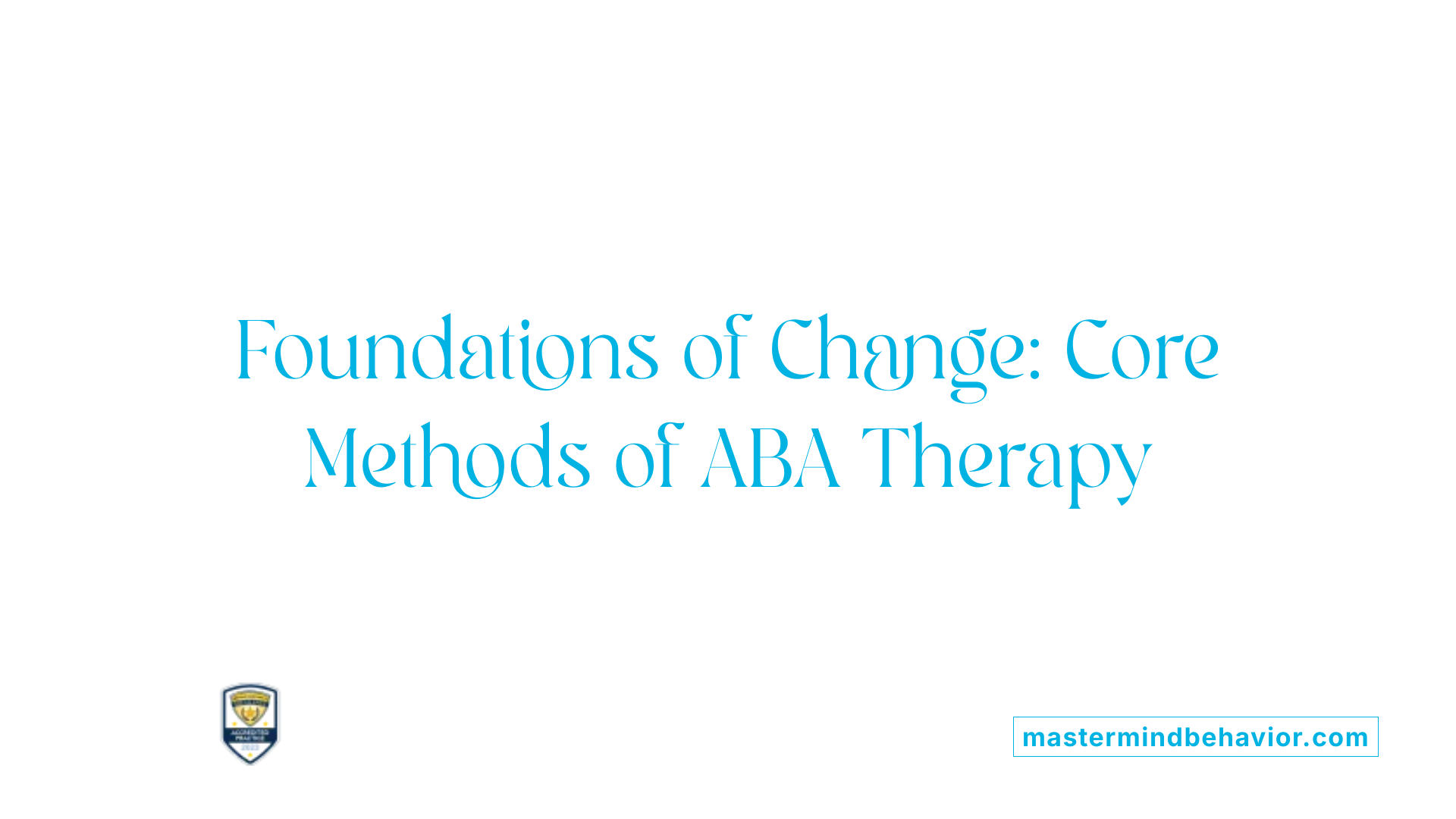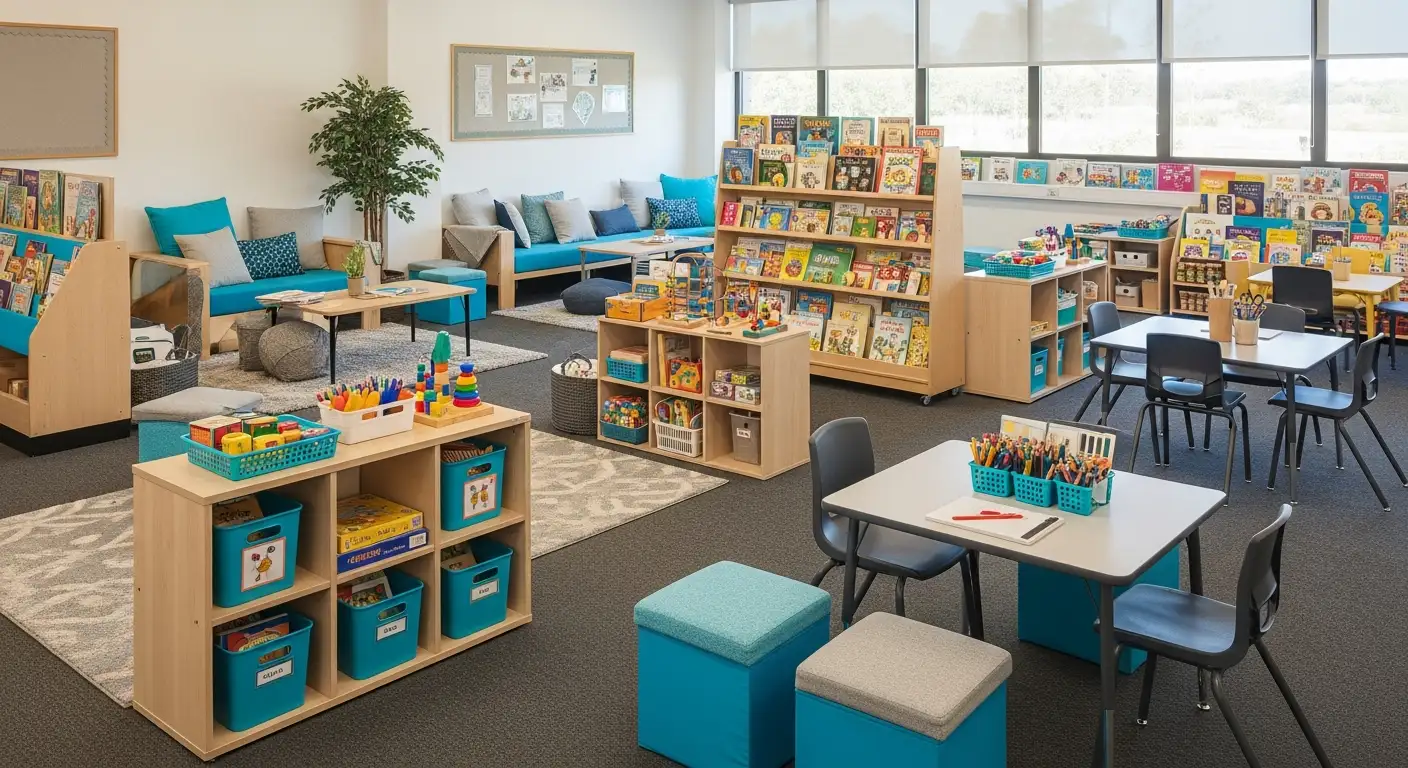How ABA Therapy Improves Morning And Bedtime Routines

Understanding ABA Therapy and Its Impact on Daily Life
Applied Behavior Analysis (ABA) therapy is a scientifically supported approach that significantly enhances the daily routines of individuals with autism. By emphasizing structured interventions and personalized strategies, ABA therapy nurtures independence, reduces anxiety, and fosters positive behaviors, particularly in morning and bedtime routines. This article explores the fundamental principles of ABA, the methods used, and the specific ways it improves daily routines for children with autism, offering families practical insights into creating consistency and stability at home.
What is ABA Therapy and How Does it Support Individuals with Autism?

Definition of ABA therapy
Applied Behavior Analysis (ABA) therapy is a science-based approach that uses behavioral principles to teach essential skills and reduce challenging behaviors in individuals with autism. It emphasizes observing and measuring behaviors, then applying strategies like positive reinforcement to encourage desired outcomes.
Science-based approach
ABA relies on decades of research supporting its effectiveness. It uses data collection to understand behaviors and tailor interventions specific to each individual's needs. This methodical, evidence-backed approach ensures that therapy is both effective and measurable.
Goals for autism support
ABA therapy aims to improve communication, social interaction, adaptive skills, and emotional regulation. It focuses on helping individuals become more independent in daily activities, such as self-care and social participation, by breaking complex skills into manageable steps.
Settings where ABA is applied
ABA can be delivered in various environments including homes, schools, and community settings. The therapy is often integrated into daily routines like mealtimes, homework, and bedtime to promote practical skill development throughout the day.
Early intervention importance
Starting ABA therapy early, typically before age six, is crucial. Early intensive intervention has been shown to yield significant improvements in communication, social skills, and overall developmental progress, leading to better long-term outcomes.
Focus on independence and quality of life
A central focus of ABA is fostering independence. Techniques such as task analysis, visual schedules, and functional communication training enable individuals to manage daily activities and express needs effectively. This empowers them with greater self-confidence and improves their quality of life.
Answer to the question: What is Applied Behavior Analysis (ABA) therapy and how does it help individuals with autism?
Applied Behavior Analysis (ABA) therapy is a science-based intervention that utilizes learning and behavioral principles to develop vital skills and reduce harmful behaviors in individuals with autism. It applies structured strategies like positive reinforcement, prompting, and data-driven customization to teach social, communication, academic, and daily living skills. ABA is flexible in its settings and methods, often incorporating naturalistic and play-based techniques to generalize skills. Early intensive ABA intervention produces marked developmental gains and better long-term outcomes. Ultimately, ABA empowers individuals with autism to achieve greater independence, social integration, and enhanced quality of life.
Professionals Behind ABA Therapy: Qualifications and Roles
Who provides ABA therapy and what qualifications do professionals typically have?
ABA therapy is delivered by specialized professionals trained in behavior analysis, including Board Certified Behavior Analysts (BCBAs) and Registered Behavior Technicians (RBTs).
Types of ABA providers
- Board Certified Behavior Analysts (BCBAs): These professionals design and oversee ABA treatment plans. They have advanced education, typically a master’s degree in behavior analysis, psychology, or related fields.
- Registered Behavior Technicians (RBTs): RBTs implement ABA interventions directly with clients, working under BCBA supervision.
Characteristics and qualifications of BCBAs and RBTs
BCBAs must complete supervised fieldwork and pass a rigorous certification exam administered by the Behavior Analyst Certification Board (BACB). They are skilled at assessing behaviors, developing personalized therapy goals, and modifying interventions based on data.
RBTs complete targeted training programs focused on ABA techniques and receive ongoing supervision to ensure adherence to treatment plans.
Training and certification requirements
- BCBAs require a graduate degree, supervised practicum hours, and BACB certification.
- RBTs must complete a competency-based training course, pass a competency assessment, and maintain certification through continuing education and supervision.
Personalized approach development
Effective ABA providers collaborate with families to gather comprehensive data and customize interventions tailored to the child’s specific needs and strengths.
Family involvement and ethical practices
Family participation is essential in ABA therapy to promote consistency and reinforce skills across settings. Providers follow ethical guidelines set forth by the BACB to ensure respect, confidentiality, and effective treatment.
How to verify provider credentials
To confirm a provider's qualifications, families can use the BACB’s online directory. Asking about a provider’s experience, certifications, and commitment to ongoing professional development helps ensure high-quality therapy.
This team approach ensures that ABA therapy is delivered safely, effectively, and compassionately, fostering meaningful improvements in children's behavior and skills.
Core ABA Methods: Building Blocks for Behavioral Change

What are the common methods used in ABA therapy for behavioral analysis?
Applied Behavior Analysis (ABA) therapy employs a variety of methods tailored to foster meaningful behavioral change, especially for children with autism. Discrete Trial Training (DTT) is a foundational technique where skills are taught systematically through repetitive, structured trials. This clear, step-by-step approach allows for precise data collection and reinforcement of desired behaviors.
Natural Environment Teaching (NET) complements DTT by encouraging learning within everyday activities and familiar surroundings. This method helps boost motivation and generalization of skills across different contexts.
Behavioral chaining breaks down complex tasks into small, manageable steps. By teaching each component sequentially, children can successfully master multi-step behaviors like dressing or brushing teeth.
Visual modeling utilizes representations such as pictures, videos, or charts to demonstrate expected behaviors. These visual aids are particularly helpful for children with autism to understand and imitate actions.
Prompting and fading techniques provide initial assistance to perform a behavior and gradually reduce support, which fosters independence over time. Reinforcement strategies, including positive reinforcement like praise or rewards, strengthen desirable behaviors and increase motivation.
Additional interventions like extinction (withholding reinforcement for unwanted behaviors), script fading (gradually reducing reliance on scripted prompts), behavior contracts, and redirection play vital roles in shaping behavior and enhancing social skills.
Collectively, these methods form the building blocks of ABA therapy, enabling personalized, evidence-based approaches that result in improved communication, independence, and emotional regulation.
Measuring Progress: How ABA Therapy Tracks Effectiveness

How is the effectiveness of ABA therapy measured in individuals with autism?
ABA therapy effectiveness is measured through systematic data collection strategies. Therapists begin by collecting baseline data to identify behaviors and challenges, which helps in creating individualized goals for each child.
Data collection strategies
Data collection methods include frequency recording (tracking how often a behavior occurs), duration recording (noting how long a behavior lasts), and interval recording (checking if a behavior happens during specific time intervals). These multiple methods provide a well-rounded view of behavior patterns.
Frequency, duration, interval recording
- Frequency: Counts instances of a target behavior (e.g., number of times a child requests an item).
- Duration: Measures the length of a behavior episode (e.g., how long a child stays in bed).
- Interval: Observes whether a behavior occurs within set time periods, helping in capturing patterns and changes.
Individualized goal tracking
Progress is tracked against personalized goals, such as improved sleep routines, enhanced communication, or decreased anxiety-related behaviors. This targeted approach ensures the therapy focuses on the child's specific needs.
Use of standardized assessment tools
Standardized tools and rating scales are sometimes incorporated to provide objective measurements of progress, complementing the observational data collected during sessions.
Ongoing evaluation and plan adjustment
The continual collection and review of data enable therapists to evaluate effectiveness regularly. Based on the findings, plans are adjusted to optimize interventions and better support the child's development.
Communicating progress to families
Families receive regular updates, often supported by visual reports and clear explanations of the data. This transparency fosters collaboration and allows caregivers to reinforce strategies at home.
Through these comprehensive data-driven strategies, ABA therapy effectively measures and supports positive change in individuals with autism, ensuring personalized and impactful interventions.
ABA's Role in Structuring Morning Routines for Children with Autism

Benefits of structured morning routines
Structured morning routines provide children with autism a clear and consistent start to their day. This stability reduces anxiety by eliminating uncertainty and promotes emotional regulation. When children know what to expect, they can focus better and transition more smoothly between tasks.
Use of visual schedules and timers
Visual schedules and timers are essential tools in ABA to create predictability in morning routines. They help children understand the sequence of activities, such as dressing, eating breakfast, and packing bags, making each step clear and manageable. These visual aids reduce stress and improve cooperation.
Task analysis to break down routines
ABA uses task analysis to divide complex morning routines into smaller, manageable steps. For instance, putting on shoes might be broken down into picking them up, inserting one foot, then the other. This approach minimizes overwhelming feelings and promotes mastery of individual skills.
Positive reinforcement of independent behaviors
Encouragement through positive reinforcement, like praise or small rewards, strengthens children's motivation to complete morning tasks independently. Recognizing and rewarding behaviors such as dressing themselves or packing their bag boosts confidence and reinforces desirable habits.
Reducing anxiety with predictability
Creating a predictable routine helps reduce anxiety by providing children a sense of control. Knowing exactly what comes next lessens resistance and emotional outbursts, fostering a calmer start to the day.
Building life skills such as dressing and packing
Consistently following a structured morning routine nurtures essential life skills. Children learn to dress themselves, pack school items, and prepare for the day ahead, building independence and self-esteem.
| Strategy | Purpose | Benefits |
|---|---|---|
| Visual schedules | Outline sequence of tasks | Enhances understanding and focus |
| Timers | Indicate time allotted per task | Improves time management |
| Task analysis | Break down complex routines | Reduces anxiety and supports skill mastery |
| Positive reinforcement | Encourage independent behaviors | Increases motivation and confidence |
| Predictability | Establish routine consistency | Lowers anxiety |
Improving Bedtime Routines: ABA Techniques for Better Sleep
Addressing sleep-related anxiety and sensory sensitivities
ABA programs often begin by collecting data to understand the causes of sleep difficulties, such as anxiety or sensory sensitivities. Therapists analyze these factors to tailor interventions that help children feel more comfortable and calm at bedtime.
Creating calming, consistent bedtime activities
Establishing a predictable bedtime routine is essential. Calming activities like reading a favorite book or listening to gentle music are incorporated consistently each night. This structured approach helps children with autism settle down more easily and reduces resistance to bedtime.
Self-soothing and gradual fading of caregiver presence
ABA therapy teaches children self-soothing techniques to promote independence in falling asleep. Caregivers gradually reduce their presence during bedtime through a process called fading, allowing the child to learn how to fall asleep on their own without anxiety.
Modifying the sleep environment
Adjustments to the sleep environment are made to accommodate sensory sensitivities. This might include controlling lighting, sound levels, or bedding textures that could disrupt sleep, thereby creating a more comfortable space conducive to rest.
Functional communication training for night wakings
Some children wake during the night seeking attention. ABA uses functional communication training (FCT) to teach alternative ways to express needs, reducing disruptive night wakings and encouraging more restful sleep.
Positive reinforcement to promote independent sleep habits
Positive reinforcement strategies play a critical role in fostering desired bedtime behaviors. Praising or rewarding children when they remain in bed or fall asleep independently motivates them to continue these healthy sleep habits.
These ABA techniques, combined in a structured, supportive routine, help children with autism develop healthy sleep patterns, ultimately contributing to improved emotional regulation and daily functioning.
Creating Consistency and Stability: The Family Advantage

How Predictable Routines Reduce Anxiety and Meltdowns
Predictable routines offer children on the autism spectrum a clear sense of structure, which reduces anxiety and stress by minimizing uncertainty. When children understand what to expect, they experience fewer overwhelming feelings, leading to a significant decrease in meltdowns and promoting emotional regulation.
Involving Caregivers in Routine Implementation
ABA therapists work closely with families to develop routines that provide stability and reassurance. Caregivers play an essential role by consistently applying ABA principles at home, reinforcing positive behaviors, and supporting skill development. Their involvement ensures the routine is personalized and feasible for daily family life.
Implementing Visual Supports Gradually
Introducing visual aids such as schedules, timers, and cues in a gradual manner helps children adjust without becoming overwhelmed. These tools clarify expectations and transitions, making daily tasks more manageable and improving children's confidence and independence.
Balancing Consistency with Flexibility
While consistency is vital for building security, routines must also allow flexibility to accommodate children's evolving preferences and needs. This balance ensures routines remain effective and supportive without causing frustration or rigidity.
Effect of Routines on Family Stress and Bonding
Structured routines enhance family life by reducing stress and easing transitions. Shared, predictable activities foster stronger family bonds and create a more peaceful home environment for all members.
Long-Term Benefits of ABA-Supported Routines
When ABA-based strategies underpin routines, children develop crucial life skills like independence, emotional regulation, and self-confidence. Over time, these improvements contribute to better functioning at home and in the community, supporting lifelong success.
The Transformative Power of ABA in Daily Routines
Applied Behavior Analysis therapy provides invaluable tools to create structured, predictable morning and bedtime routines that significantly improve the lives of children with autism and their families. Through evidence-based methods like positive reinforcement, task analysis, and visual supports, ABA fosters independence, reduces anxiety, and builds essential life skills. Caregivers equipped with ABA strategies can cultivate environments rich in consistency and flexibility, promoting emotional regulation and smoother transitions. Embracing ABA therapy for daily routines not only enhances individual capabilities but also strengthens family dynamics, offering a pathway toward greater stability and well-being.
References
- How ABA Can Improve Your Child's Sleep
- ABA Techniques for Daily Routines: Using Therapy ...
- How Consistent Routines Help Children with Autism Thrive
- Finding A Qualified ABA Provider - Linx
- Qualifications of Behavior Service Providers
- ABA Techniques: Strategies for Behavior Analysts - GSEP Blog
- Applied Behavior Analysis (ABA)
- 10 Common ABA Therapy Techniques
Recent articles

ABA Therapy For Teaching Long-Term Planning And Goal Achievement
Unlocking Future Success: How ABA Therapy Shapes Long-Term Planning and Goal Achievement in Autism

How ABA Therapy Helps With Following Community Safety Rules
Enhancing Safety and Independence: The Role of ABA Therapy in Community Rule Compliance

How ABA Therapy Improves Behavior In Inclusive Classrooms
Transforming Inclusive Education: The Role of ABA Therapy in Behavior and Skill Development

Teaching Personal Hygiene Routines Through ABA Therapy
Empowering Independence: How ABA Therapy Transforms Hygiene Skills in Children with Autism

The Importance Of Generalization In ABA For Long-Term Outcomes
Maximizing Life Skills Through Effective Generalization in Autism Therapy

How Functional Communication Training Reduces Problem Behaviors
Transforming Challenging Behaviors Through Functional Communication Training



